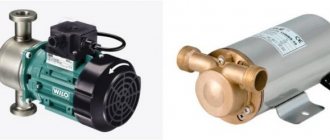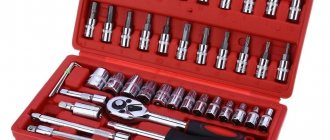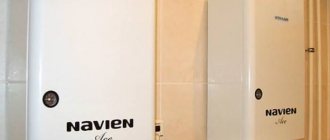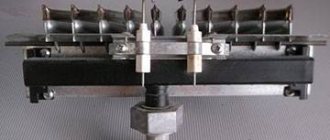Pressure in the accumulator and expansion tank
Let the minimum allowable pressure in the system (heating - for an expansion tank, water supply - for a hydraulic accumulator, when the relay is triggered and the pump turns on) is X atmospheres. Then the optimal pressure in the device in the absence of water in it (it is empty) should be 90% of X. You need to check the pressure by completely draining the water. Otherwise, measurements will give nothing.
In general, air from accumulators and expansion tanks can gradually escape. But checking the air sufficiency regularly is difficult. To carry it out, you need to drain all the liquid from the device, which is not always possible. But there are signs that clearly indicate that the air has escaped. For a hydraulic accumulator, this is too frequent turning on of the pump, for an expansion tank, a strong change in pressure in the system when the temperature of the coolant changes. Therefore, immediately after installing the tank, you need to measure how many percent the pressure changes when the medium in the system is fully warmed up, write down this value, and then make sure that this value does not increase too much, pump it up as needed. For the accumulator, you need to measure the time between turning on the pump and turning it off, and also make sure that this time remains constant.
Repair or how to glue
The membrane can be repaired by vulcanization. This method can extend its life by several weeks before purchasing and installing a serviceable product. But any repairs are a temporary measure and in any case you will have to buy a new one.
Accumulator without diaphragm
In addition to standard factory-made hydraulic tanks, you can make such a device yourself. A hydraulic accumulator without a membrane is a normal water tank because it is the membrane that helps maintain the pressure in the system. It is much easier to buy an inexpensive ready-made hydraulic accumulator.
In order to build a hydraulic accumulator yourself, you need the following materials:
- tank (capacity) with a volume of at least 30 liters;
- shut-off valves;
- ball valve;
- half-inch faucet;
- fasteners (washers and nuts);
- sealant (sealant);
- rubber gaskets;
- nipple;
- fittings (tee, worm).
- Make holes in the container (on the lid and bottom, on the side).
- Install a half-inch valve in the upper hole (on the cover), seal the connection with gaskets and sealant, and secure with washers.
- Put a tee on the tap.
- Fix a shut-off valve ¾ in the lower hole, onto which to slide a tee.
- Install a ball valve on the side hole.
A malfunctioning accumulator can affect the operation of the entire water supply system. By applying the tips and techniques described in the article, it is easy to troubleshoot your home plumbing system. Timely prevention can prevent serious breakdowns and premature failure of hydraulic tanks and the entire system as a whole.
An autonomous water supply system, which is based on a pump that pumps liquid from a well or well, in some suburban villages is the only way to provide a private house with water. It works as needed to use water: opening the tap, turning on the pumping device, the flow of liquid. In order to reduce the number of switching on and off of the pumping unit, which reduce its operational resource, a hydraulic accumulator is mounted in the water supply network.
Design differences
First of all, you need to understand that a hydraulic accumulator and an expansion tank, despite the assurances of some unscrupulous managers, are not the same thing. Their design differences are due to the specifics of the application. Installing an expansion tank as a hydraulic accumulator is fraught with unpleasant consequences.
The bottom line is that in the expansion tank for the heating system, the membrane divides the internal volume in half. Initially, the air pumped into the lower half creates enough pressure for the membrane to be completely pressed against the inner surface. As the temperature of the coolant rises, its volume increases, the pressure increases and water begins to flow into the upper half, squeezing out the membrane. Accordingly, the air in the lower half is compressed. The accumulator differs in that a balloon membrane is installed in it, entering into which water does not come into contact with the inner walls.

Closed expansion vessels: with diaphragm diaphragm, with balloon diaphragm
Considering the difference between an expansion tank and a hydraulic accumulator, it is necessary to understand that they work in different conditions. The change in the volume of liquid in the heating system is insignificant, in addition, it happens slowly, without sudden jerks. However, temperatures can reach 90 ° C. Therefore, the first requirement for such a membrane is resistance to prolonged exposure to high temperatures.
For a bladder diaphragm in a cold water accumulator, high temperature resistance is not so important, but the ability to operate in a frequent expansion / contraction mode is key.
Unfortunately, there is no universal material that is equally resistant to high temperatures and regular stretching. Diaphragms in modern expansion tanks are made of the following materials:
- NATURAL - can be operated at operating temperatures from -10 to 50 ° С. Extremely flexible material, however, partial diffusion can occur with use. Natural rubber rubber can be used for both drinking and industrial water; - BUTYL - operation at temperatures from -10 to 100 ° C is possible. More stable in terms of diffusion, but not as elastic as NATURAL. Synthetic butyl rubber can be used as a membrane for a hydraulic accumulator; - EPDM - works at temperatures from -10 to 100 ° C. More water permeable than BUTYL. Synthetic ethylene / propylene rubber is installed in tanks for drinking or service water; - SBR - operation at temperatures from -10 to 100 ° C is permissible. Less elastic It is used exclusively in expansion tanks of the heating system, not elastic enough for installation in hydraulic accumulators; - NITRIL - works at temperatures from -10 to 100 ° С. Resistant to active media.
The scope of application of expansion tanks is not limited to heating systems and water supply, they are successfully used to store extinguishing liquid in automatic fire extinguishing systems, as well as as part of a powder fire extinguishing module.
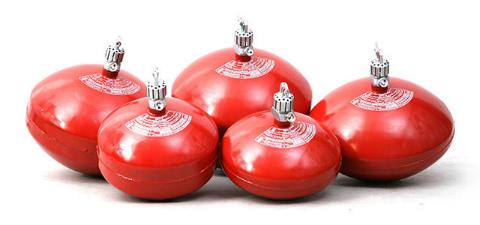

Regardless of the type, the accumulator and expansion tank are an integral part of any life support system and provide a high level of comfort and safety of living.
The choice of a hydraulic accumulator, expansion tank. Service. Exploitation. Repairs. (10+)
Hydraulic accumulator, expansion tank. Features of choice
The accumulator and expansion tank are designed for slightly different purposes, but they have almost the same structure, so I combined them in one article. The hydroaccumulator is designed to accumulate water in the autonomous water supply system, protect the system from overpressure, and exclude frequent switching on of the pump.The expansion tank is installed in the heating system. It protects it from overpressure that can occur when water (or other heat carrier) expands from an increase in temperature. The key difference between the hydraulic accumulator and the expansion tank is that the expansion tank must operate at a sufficient temperature; such requirements are not imposed on a hydraulic accumulator for cold water. But on the other hand, for most accumulators there are high requirements for the quality of the membrane material, since they are used in the supply of water that can be used for food. For an expansion tank, such requirements are less critical.
Why do you need
Many ordinary people who are going to mount a water supply system, having familiarized themselves with the device of a hydraulic tank, do not fully understand why this unit is needed in an autonomous water supply system.
For greater awareness, it is worth noting the fact that the accumulator is designed to perform a number of the following tasks:
- accumulates a reserve stock of water in case of emergencies in water supply;
- stabilizes excess pressure that appears in the water supply;
- protects the pipeline from water hammer that occurs when the pump is turned on for water intake;
- maintains a stable water pressure in the pipes when the pump is off;
- contributes to the long-term operation of the pump, since the pump unit turns on much less often;
- promotes uniform water supply at moments of maximum consumption.
Design and purpose of devices
Expansion tank
- The main purpose of the tank is to compensate for the expansion of the coolant. When heated, the water increases in volume, and quite strongly (+ 0.3% for every 10 degrees Celsius). In this case, the liquid practically does not shrink, so that the heated coolant will exert significant pressure on the pipe walls, joints and shut-off valves.
- To compensate for this pressure, as well as to minimize the effects of water hammer, an additional reservoir is built into the system - an expansion tank. The first tanks had a leaky design, but pneumohydraulic models are almost universally used today.
- Inside such a tank is a membrane made of elastic material. Since the membrane is in contact with a heated coolant, it is made of polymers that are resistant to high temperatures - EPDM, SBR, butyl rubbers and nitrile rubbers.
- The membrane divides the tank into two cavities - a working one (the coolant enters it) and an air one. With increasing pressure in the system, the air chamber decreases in volume (due to air compression), and this compensates for the load on the pipes and valves. Roughly the same thing happens with a water hammer - but here the process goes at a higher speed.
- With a decrease in the temperature of the coolant, the volume of water decreases, and the air, putting pressure on the membrane, displaces an additional volume of hot water into the pipes of the heating system.
Hydroaccumulator
The hydraulic accumulator, at first glance, practically does not differ in design from the expansion tank:
- The base is the same container made of corrosion-resistant steel, only painted blue.
- There is also a membrane inside the tank - though slightly different in shape from the expansion tank membrane.
- The internal volume is also divided into two chambers, only for hydroaccumulators the chamber for water is inside the membrane, i.e. contact of the liquid with the metal walls of the tank is completely excluded.


And the structure functions according to a similar principle, although it is used for a different purpose:
- When the pump is turned on or water is supplied through the centralized water supply, the chamber is filled with liquid at a certain pressure.
- If the pressure drops for some reason, the air chamber expands and water from the working chamber enters the system.Thanks to this, the pressure in the pipes is stabilized, and the equipment (washing machines, dishwashers, etc.) works without interruptions.
- The second aspect of the accumulator's operation is to protect the pump from frequent switching on. As long as it is possible to compensate for the withdrawal of water from the system at the expense of the reserve in the tank, the pressure switch will not work, and the pump will not start pumping water. Thus, the equipment will be turned on less often, which means it will work longer.
- A large accumulator (for 50, 100 or more liters) is also a supply of water. Yes, you won't last long on such a stock, but if you spend it economically, it is quite possible to survive an accident on the water supply system or a power outage, which will make the pump impossible to operate.
- In addition, the hydraulic accumulator, like the expansion tank, compensates for water hammer.
Required volume of accumulator and expansion tank
You need to clearly understand that the volume of these devices, which is given in the specification, is the volume of the tank itself. It fits less liquid. The volume of the liquid depends on the pressure.
Determining the volume of the expansion tank is quite simple. You need to understand how much water (or antifreeze) will be in your heating system. We take the coefficient of thermal volumetric expansion of water with a margin of 6E-4. Thus, the volume of water when heated from zero to 100 degrees will increase by 0.06 times, that is, by 6%. If there are 100 liters of water in the system, then the excess volume will be 6 liters.
Now we need to decide on the permissible coolant pressure in the heating system. Let the minimum value be X1 and the maximum X2. This is usually 1.8 atmospheres and 2.4 atmospheres. If the pressure in the empty expansion tank is 90% of the minimum allowable for the coolant (let it be X0), then [The required volume of the expansion tank, liters
] = [
0.06
] * [
Coolant volume in the system, liters
] / (([
X0, liters
] + [
1
]) / ([
X1, liters
] + [
1
]) — ([
X0, liters
] + [
1
]) / ([
X2, liters
] + [
1
])). For our case with 100 liters of media, we get 36 liters. In this case, more is not less. You can take it with a margin, but this volume will be enough.
The accumulator volume depends solely on the maximum peak water flow. If one tap can work in the house at the same time, then the volume of the accumulator should be about 30 liters, if two taps - 60 liters, if 3 - 90, and so on.
Connecting the accumulator to the system
Typically, the water supply system of a private house consists of:
- pump;
- hydroaccumulator;
- pressure switch;
- check valve.
In this scheme, a pressure gauge may still be present - for operational pressure control, but this device is not necessary. It can be connected periodically to carry out test measurements.
With or without 5-way union
If the pump is of the surface type, the accumulator is usually placed near it. In this case, a check valve is installed on the suction pipeline, and all other devices are installed in one bundle. They are usually connected using a five-way union.
It has leads with different diameters, just for the device used for piping the accumulator. Therefore, the system is most often assembled on its basis. But this element is not at all necessary and you can connect everything using ordinary fittings and pieces of pipes, but this is a more laborious task, besides there will be more connections.
With one inch outlet, the fitting is screwed onto the tank - the fitting is located at the bottom. A pressure switch and a pressure gauge are connected to the 1/4 '' outlets. The pipe from the pump and wiring to consumers are connected to the remaining free inch outputs. That's all the connection of the gyroaccumulator to the pump. If you are assembling a water supply circuit with a surface pump, you can use a flexible hose in a metal winding (with inch fittings) - it is easier to work with it.
As usual, there are several options, you can choose.
Connect the accumulator to the submersible pump in the same way. The whole difference is where the pump is installed and where to supply power, but this has nothing to do with installing a hydraulic accumulator. It is placed in the place where the pipes from the pump go. Connection - one to one (see diagram).
How to install two hydraulic tanks on one pump
When operating the system, sometimes the owners come to the conclusion that the available volume of the accumulator is not enough for them. In this case, you can install a second (third, fourth, etc.) hydraulic tank of any volume in parallel.
There is no need to reconfigure the system, the relay will monitor the pressure in the tank on which it is installed, and the viability of such a system is much higher. After all, if the first accumulator is damaged, the second will work. There is one more positive point - two tanks of 50 liters each cost less than one per 100. The point is in a more complex technology for the production of large-sized containers. So it is also more cost effective.
How to connect a second accumulator to the system? Screw a tee onto the input of the first one, connect the input from the pump (five-way fitting) to one free output, and the second container to the remaining free output. Everything. You can test the circuit.
Repairs
Common malfunctions are: breakage of the air check valve (nipple) and damage to the diaphragm. The check valve can be replaced by supplying from a car tire. They fit in most accumulators and tanks. Damage to the diaphragm can only be repaired in repairable (dismountable) devices. I myself have done this a couple of times successfully. It is necessary to disassemble the tank, remove the membrane, thoroughly wash and dry it, find the place of damage, degrease, glue or vulcanize it
When choosing an adhesive, be sure to pay attention to whether it is waterproof, elastic, can it be used for high temperatures (for an expansion tank), can it come into contact with food (for a hydraulic accumulator)
Unfortunately, errors are periodically encountered in articles, they are corrected, articles are supplemented, developed, new ones are being prepared. Subscribe to the news to keep up to date.
I have such a question - is it possible to use a container with one input as a hydroaccumulator. Will water compress the air inside the tank and thus act as a damper? I mean there is no membrane in the design. Read the answer.
Forced circulation heating system. Organization of forced circulation of the coolant in the heating system circuits.
Fill in the coolant. How to replace antifreeze in the heating system. How to properly fill the heating system with coolant, choose between water and.
Pipe heating system so that the winter water supply does not freeze. With your hand. DIY plumbing. External, non-freezing. Laying water pipes h.
Gas into the house is autonomous. Is it real? Personal experience. Feedback. Installation errors. Review of the experience of autonomous gasification, installation of a gasholder for liquefied gas. T.
Tight threaded pipe connection. Plumbing glue - sealant. How to properly thread pipes in a pipeline? Ensuring tightness.
Personal experience in the selection of a gas burner for heating according to the characteristics of K. How to choose the right gas burner for heating. Tips. Personal experience. Feedback.
In order to prevent the pump from turning on every time a tap is opened in the house, a hydraulic accumulator is installed in the system. It contains a certain volume of water, sufficient for a small consumption. This allows you to practically get rid of short-term pump starts. The installation of a hydraulic accumulator is not difficult, but a certain number of devices will be required - at least - a pressure switch, and it is also desirable to have a pressure gauge and an air vent.
What should be the pressure in the accumulator
In one part of the accumulator there is compressed air, in the second water is pumped.The air in the tank is under pressure - factory settings - 1.5 atm. This pressure does not depend on the volume - it is the same on both a 24-liter tank and a 150-liter tank. More or less can be the maximum permissible maximum pressure, but it does not depend on the volume, but on the membrane and is indicated in the technical specifications.
Pre-check and pressure correction
Before connecting the accumulator to the system, it is advisable to check the pressure in it. The settings of the pressure switch depend on this indicator, and during transportation and storage, the pressure could drop, so control is very desirable. You can control the pressure in the gyro tank using a pressure gauge connected to a special inlet in the upper part of the tank (capacity from 100 liters and more) or installed in the lower part of it as one of the strapping parts. Temporarily, for monitoring, you can connect a car pressure gauge. His error is usually small and it is convenient for them to work. If this is not the case, you can use the standard one for water pipes, but they usually do not differ in accuracy.
If necessary, the pressure in the accumulator can be increased or decreased. There is a nipple for this at the top of the tank. A car or bicycle pump is connected through the nipple and, if necessary, the pressure is increased. If it needs to be vented, bend the valve of the nipple with some thin object, releasing the air.
What air pressure should be
So should the pressure in the accumulator be the same? For normal operation of household appliances, a pressure of 1.4-2.8 atm is required. To prevent the tank membrane from breaking, the pressure in the system should be slightly higher than the tank pressure - by 0.1-0.2 atm. If the pressure in the tank is 1.5 atm, then the pressure in the system should not be lower than 1.6 atm. This value is set on the water pressure switch, which works in tandem with a hydraulic accumulator. These are the optimal settings for a small one-story house.
If the house is two-story, you will have to increase the pressure. There is a formula for calculating the pressure in the hydraulic tank:
Vatm. = (Hmax + 6) / 10
Where Hmax is the height of the highest draw-off point. Most often it is a shower. You measure (calculate) at what height its watering can is relative to the accumulator, substitute it in the formula, you get the pressure that should be in the tank.
If a jacuzzi is installed in the house, everything is more complicated. We'll have to select it empirically - changing the relay settings and observing the operation of the water points and household appliances. But at the same time, the working pressure should not exceed the maximum allowable for other household appliances and plumbing fixtures (indicated in the technical specifications).
How to choose a hydraulic accumulator? What should be its volume?
Accumulator tank (or hydroaccumulator) Is a water tank with an elastic rubber membrane in the form of a pear, located inside and hermetically connected to the metal body of the hydraulic tank by a flange having a threaded connection for connection to the water supply network. The space between the metal body of the accumulator and the membrane is filled with air, the pressure of which is 1.5-2 bar. Hydraulic storage tanks are used to mitigate water hammer and maintain constant pressure in both domestic and industrial installations. After all, it is the accumulator that, when the pump is off, provides the pressure in the water supply system. I have already talked about the use of a hydraulic accumulator as part of a household pumping station. Let us dwell in more detail on the device of the accumulator and the principle of its operation. So…
The principle of operation of the accumulator
The accumulator consists of a body with a rubber membrane, a flange, a nipple for pumping air into the cavity, an air vent valve, a fitting for attaching the membrane, etc.
What is the principle of operation of a hydraulic accumulator?
When water enters under pressure from a well or well, the membrane connected to the water supply system increases in volume. Accordingly, the volume of air trapped between the metal walls of the hydraulic tank and the membrane begins to decrease, thereby creating even more pressure.
As soon as the set pressure level is reached, the pressure switch opens the contacts for supplying electricity to the pump and it turns off. So what happens? The air between the membrane and the hydroaccumulator body presses under pressure on the “bulb” with water inside.
When you open the tap to supply water, pressurized air on the membrane will push water from the hydraulic tank to your tap. In this case, the pressure pumped up by the pump will drop in the membrane as the water is consumed. And as soon as it drops to the set level, the contacts on the pressure switch will close again and the pump will start working again.
Thus, the accumulator always contains both water and air, separated from each other by a rubber membrane. It should be noted that the pressure of the air in the cavity of the accumulator may decrease during operation.
It is recommended to check the air pressure in the hydraulic tank once a year when there is no water in it. If it is less than the norm, you can pump it through the nipple using a simple automobile pump. It should also be borne in mind that water never completely fills the entire volume of the accumulator.
The actual volume of water in it depends on a number of parameters: on the shape of the accumulator, the initial air pressure in it, the geometric shape and elasticity of the diaphragm, the specified upper and lower limits of the pressure switch, etc.
Accumulators, depending on the method of their installation, are horizontal and vertical. Which accumulator is better to choose? If the dimensions of the room allow, then you should pay attention to how the air accumulating inside the rubber membrane is removed.
The thing is that dissolved air is always present in the water supply system. And over time, this air is released from the water and accumulates, forming air locks in various places in the system.
To remove air locks in the design of large-volume accumulators (100 liters or more), a fitting is additionally provided on which a valve is installed, through which the air accumulating in the system is periodically vented.
In vertical accumulators with a capacity of 100 liters or more, all air accumulates in their upper part and is removed using this air vent valve.
In horizontal accumulators, air can be removed using an additional section of the pipeline, which consists of a ball valve, an outlet air nipple and a drain into the sewer. Accumulators with a small volume do not have such a fitting. Their choice is justified only by the convenience of the layout in a small room. Removal of the air accumulating in them is possible only with periodic complete emptying.
How to choose a hydraulic accumulator? Calculation of the volume of the accumulator
How to calculate the volume of a hydraulic accumulator? In order to answer this question, you must first determine its purpose:
- to avoid excessively frequent switching on of the pump;
- to maintain pressure in the system when the pump is off;
- for some water reserve;
- to compensate for peaks in water consumption.
It is worth noting that the closer you install the hydraulic tank to the pump, the better it will work.
For example, if you install a pump in the basement and put the first accumulator next to it, and throw the second one into the attic, then the volume of water in the second hydraulic tank will be less, since the water pressure will be lower at the attic level.If you install both accumulators on the ground floor, then their filling will be almost the same.
The choice of a hydraulic accumulator in terms of using it to provide a reserve of a certain amount of water in the event of a power outage depends on what reserve you need.
And how to choose a hydraulic accumulator to avoid frequent switching on of the pump? As you know, it is not recommended to turn on the pump more than once a minute.
In domestic systems, as a rule, pumps are used with a capacity of approximately 30 l / min (1.8 m3 / h).
Taking into account the fact that the water in the accumulator occupies about 50% of the volume (the rest is air under pressure), then the accumulator with a volume of 60-80 liters will easily cope with this task.
When choosing a hydraulic accumulator from the point of view of compensating for peak values during water consumption, it is necessary to consider some of the flow characteristics of water consumption points in everyday life:
- toilet - 1.3 l / min;
- shower - 8-10 l / min;
- kitchen sink - 8.4 l / min.
Let's say that we have two toilets, and all of the above points simultaneously consume water. The total volume is approximately 20 liters.
Considering the percentage of water filling in the hydraulic tank and the fact that pump manufacturers allow no more than thirty pump starts per hour, a volume of 60–80 liters in our example will be quite enough for the tank.
How to calculate the air pressure in the accumulator?
What air pressure in the accumulator should be initially? If it is installed in your basement, then the minimum pressure value can be easily calculated. To do this, take the height in meters from the top point of the water supply system to the basement.
For example, for a house of two floors, this is about 6-7 meters. Then we add 6 to this number and divide by 10. As a result, we get the value we need in atmospheres.
So, for example, for a two-story house, the calculated value of the minimum air pressure in the accumulator is (7 + 6) / 10 = 1.3 atmospheres. If the pressure in the accumulator is less than this value, then water from it will not flow to the second floor.
You should also not overestimate these values, otherwise there will simply be no water in the hydraulic tank. The air pressure set by the manufacturers is usually 1.5 atm., But it may also happen that the pressure value in the accumulator you purchased will be different.
Therefore, immediately after purchase, check the air pressure inside the accumulator using an ordinary pressure gauge, connecting it to the hydraulic tank nipple, and, if necessary, increase the pressure using an automobile pump.
When using the hydraulic tank in combination with a pump, the air pressure in it must be the same as the lower limit for switching on the pump. And what the lower and upper limits are (the limits for turning on and off the pump, respectively) and how they are regulated, we talked about in the article on setting up and adjusting the pressure switch.
Source: https://muzhik-v-dome.ru/vodosnabzhenie/kak-vyibrat-gidroakkumulyator/
How to choose
The main working body of the hydraulic tank is a membrane. Its service life depends on the quality of the material. The best today are membranes made of isobutated rubber (also called food grade). The body material matters only in membrane-type tanks. In those in which the "pear" is installed, water is in contact only with rubber and the material of the body does not matter.
What's really important about pear tanks is the flange. It is usually made of galvanized metal.
In this case, the thickness of the metal is important. If it is only 1 mm, after about a year and a half of operation, a hole will appear in the metal of the flange, the tank will lose its tightness and the system will stop working. Moreover, the warranty is only one year, although the declared service life is 10-15 years.The flange usually deteriorates after the end of the warranty period. There is no way to weld it - a very thin metal. You have to look for a new flange in service centers or buy a new tank.
So, if you want the accumulator to serve for a long time, look for a thick galvanized flange or a thin one, but made of stainless steel.
Possible breakdowns and their symptoms
Various malfunctions of a hydraulic accumulator for water supply systems can have similar external manifestations, so it is important to check all options.
Reasons for frequent switching on of the pumping unit and solutions to the problem:
- low pressure or lack of compressed air - pump up with a pump,
- damage to the membrane or pear - replace the element yourself or with the help of a specialist,
- damage to the case - have it replaced at a service center,
- slight difference between the thresholds on the relay - change the settings.
Other possible malfunctions:
- the appearance of water in the air valve indicates damage to the membrane and requires its replacement,
- a rapid drop in air pressure can be avoided by blowing out the nipple (the pressure is restored to the calculated one by pumping).
In most cases, a correctly selected and correctly installed accumulator is reliable and does not cause trouble for its owners. Knowing how the accumulator works, it is not difficult to maintain such equipment, and most of the problems can be fixed on your own.
Expansion tank
Heating water is used to transfer heat from the boiler to the radiators. It is known that when heated by 10 ° C, the volume of water increases by about 0.3%, from which it follows that heating to the prescribed 70 ° C will give an increase in volume by about 3% of the original. It is known from the school physics course that liquids are practically incompressible, therefore even such a seemingly insignificant increase in volume can lead to a rupture of the pipeline or leaks at the joints. In order to prevent this from happening, an expansion tank is installed in the heating system.


Initially, such containers were open, which led to certain problems:
- the liquid in them constantly evaporates, you have to monitor the water level and regularly replenish it; - an open expansion tank should be installed in the upper part of the system and insulated to prevent the coolant from freezing and, as a result, the structure's rise in price; - constant access of oxygen promotes corrosion; - pressure regulation with an open circuit is difficult.
Modern materials and, in particular, a strong and elastic membrane material, make it possible to equip a closed system, without oxygen access to the coolant. This also allows for a constant water level and the ability to adjust the pressure. Another advantage of the closed container is that it is easy to install and maintain. It can be installed anywhere in the heating system and, if necessary, can be easily dismantled and connected elsewhere.
Equipment service
The principle of operation of the accumulator and its design have an undoubted advantage - the equipment does not require complex maintenance.
If no breakdowns have occurred, only once every 4 years it will be necessary to dismantle the tank with the replacement of the pear or membrane and, depending on the condition, the flange.
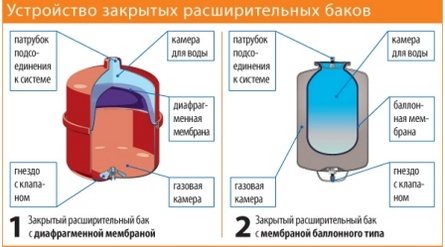

Various types of accumulators
In addition, once every six months, the air pressure is checked and restored, if necessary, at the moment the unit is turned on, at the same time the accuracy of the relay is monitored.
It is enough to check the tightness of the joints once a month. If the accumulator has a volume of 100 liters or more and is equipped with an air bleed valve, the formed air bubble at the top of the reservoir is removed at the same time.
As we have already found out, the pressure switch is a constant "partner" of the accumulator.The connection diagram of the water pressure switch for the pump is described in a separate article.
Also, the pressure switch needs to be properly adjusted, our instructions will help you with this.
And tips on choosing a hydraulic accumulator can be found here.



